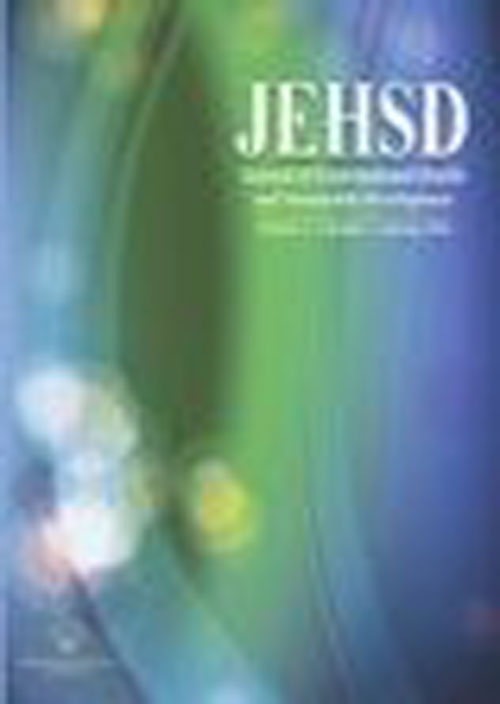فهرست مطالب

Journal of Environmental Health and Sustainable Development
Volume:6 Issue: 3, Sep 2021
- تاریخ انتشار: 1400/07/06
- تعداد عناوین: 8
-
-
Pages 1330-1331
-
Pages 1332-1339Introduction
Cutaneous leishmaniasis is one of the health concerns in Iran. Numerous studies have examined the role of blood type in people with the disease. Therefore, this study aimed to investigate the prevalence of leishmaniasis in different blood groups as a review in Iran.
Materials and MethodsFor this review, two researchers evaluated the extracted articles in terms of relevance to the purpose of the study after searching four databases, including Scopus, Web of Science, PubMed, and Science Direct. Literature reports on the prevalence of leishmaniasis in different blood groups in Iran until the end of March 2021. Relevant information included study time, study tool, number of subjects, mean age, and the relationship between blood type and infection which were recorded in Excel form.
ResultsAfter searching, screening, and qualitative evaluation of the studies, out of 135 identified articles, five papers met the required requirements. These five articles were published from 1999 to 2012, three studies examined the relationship between cutaneous leishmaniasis with different age groups. Also, three studies experimentally evaluated the relationship between cutaneous leishmaniasis with different human blood groups.
ConclusionAccording to the results of the present review, cutaneous leishmaniasis is more common in some blood groups. Studies have shown that Rh-negative blood groups with B alleles are more affected by cutaneous leishmaniasis than others; however, more studies are required.
Keywords: Leishmaniasis, Cutaneous, Blood Group Antigens, Iran -
Pages 1340-1356Introduction
An instance of fish deaths in marine waters surrounding some communities in Bonny and Andoni Local Government Areas in Rivers State was reported in March-April 2020. This study investigated trace metals hazard in muscle of Tilapia (Sarotherodon melanotheron) and Silver Catfish (Chrysichthys nigrodigitatus) from Okulu River, Rivers State, Nigeria.
Materials and MethodsTissues of 24 samples of Sarotherodon melanotheron and Chrysichthys nigrodigitatus obtained from the river were analyzed using atomic adsorption spectrophotometer, and the health risk was estimated based on estimated daily intake (EDI), target hazard quotient (THQ), and total target hazard quotient (TTHQ).
ResultsThe concentration (mg/kg) of iron, zinc, manganese, copper, cadmium, lead, and chromium in both species ranged 4.00 – 197.30, 9.20 – 35.30, 0.20 – 5.00, 0.00 – 73.10, 0.00 – 1.30, 0.00 – 54.70, and 0.00 – 0.50, respectively. The EDI of trace metals resulting from the consumption of both fish species was higher than the permissible tolerance intake (PTI) mg/day/60kg body weight. The THQ and TTHQ were < 1, indicating that the consumption of this food fish portends no known health concern. However, the carcinogenic risks exceeded the threshold level of 10-6 - 10-4, thus, reflecting carcinogenic tendency. Based on the results obtained, it must be ensured that the effluents discharged into open water bodies meet the recommended limits.
ConclusionThere is a need to create awareness among consumers of food fish in the study area. There should be periodic monitoring of trace metals in surface waters and its food fish population to forestall potential health impact on humans.
Keywords: Aquatic Ecosystem, Environmental Health, Food Fish, Risk Assessment, Surface Water Contamination, Nigeria -
Pages 1357-1366Introduction
Understanding the epidemiological pattern and causes of poisoning is the first step to prevent and reduce complications and mortality due to poisoning in children. Given that no study has been conducted on this subject in Yazd, this study aimed to determine the epidemiology pattern of poisoning in children admitted to the referral teaching hospitals in Yazd and Taft cities during 2014-2019.
Materials and MethodsThis descriptive cross-sectional study was conducted on 238 children under the age of 15 who have been admitted to Shahid Sadoughi hospital in Yazd and Shahid Beheshti hospital in Taft city during 2014-2019. The data were analyzed by SPSS version 20.0 using descriptive statistics, Pearson correlation, and Chi-square. In all the statistical analyses, a P-value of less than 0.05 was considered significant.
ResultsThe results showed that the frequency of poisonings was higher in girls (58%), in summer (31.1%), and in urban areas (82.8%). Most cases of poisoning aged less than 15 years (75.1%). The main cause of poisoning in children was drug poisoning (60.5%), followed by cleansing products (10.1%). The most common clinical manifestations included neurological signs (33.6%). During 2014-2019, the frequency of drugs and pesticide poisonings decreased; while poisoning due to drug-opioids and cleansing products increased (P = 0.04). Also, 3 deaths occurred due to poisoning during this period.
ConclusionThe higher prevalence of drug and cleansing products poisoning in children under the age of 15 indicates involuntary poisoning in this group. Therefore, proper storage of these substances and more parental care can reduce poisonings in children.
Keywords: Poisoning, Epidemiology, Child, Yazd City -
Pages 1367-1375Introduction
Since phthalate esters and their derivatives have the potential to disrupt proper endocrine function, these compounds are considered as one of the most important groups of endocrine-disrupting chemicals. The presence of these compounds in various aquatic environments has caused main concerns about human and animal health and causes problems in the environment.
Materials and MethodsThe treatment process was carried out in a glass reactor containing 200 mL polluted water at room temperature. The Mg-Al layered double hydroxides (Mg-Al-LDH) were successfully synthesized and were applied as adsorbents for the removal of Diethyl Phthalate (DEP) from polluted water. The kinetics and isotherm of the process were investigated to determine the exact mechanism of DEP removal from the water medium.
ResultsThe Mg-Al-LDH was a surface area of 673 (m2 g-1), a total pore of 0.716 (cm3 g-1), and microspore volumes of 0.627 (cm3 g-1), and a pore diameter of 8.64 nm. The maximum DEP removal efficiency of 96.7% was obtained at the DEP concentration of 10 mg L-1, Mg-Al-LDH dosage of 0.50 g L-1, and the reaction time of 30 min. The second-order kinetic model well depicted the kinetics of DEP adsorption (R2 = 0. 99). The Langmuir isotherm model best described the data by predicting the maximum adsorption capacity (qm) of 95.6 mg g-1 and R2 of 0.99.
ConclusionAll the results demonstrate that the Mg-Al-LDH is an efficient, safe, and efficient adsorbent in water and wastewater treatment.
Keywords: Diethyl Phthalate, Hydroxide, Mg-Al–Layered Double Sustainable Nanoadsorbent, Water, Wastewater Treatment -
Pages 1376-1387Introduction
The post-harvest damage to fruits is estimated to be about 10-30% of the total products, which reaches up to 30-50% in some perishable fruits. About 25 species of fungi and bacteria including Botrytis spp. and in particular Botrytis cinerea are known to contaminate fruits, vegetables and ornamental greenhouse plants. The aim of this study was to investigate the antifungal activity of different concentrations of Zataria multiflora essential oil (ZEO) against B. cinerea.
Materials and MethodsThe ZEO was extracted through steam distillation and analyzed by gas chromatography-mass spectrometry. The strawberries packages were exposed to ZEO with different concentrations (0, 200, 400, 600, and 800 ppm) and satarch nanoparticles. The exposed fruits were kept for 24 days at two temperatures of 20°C and 4°C.
ResultsThe ZEO decreased mycelium growth even when only 200 ppm of it was added to each container. The response was dose-dependent, so that the 800 ppm dose of ZEO showed complete inhibitory effect. The minimum inhibitory concentration (MIC) and minimum fungicidal concentration (MFC) values for ZEO against B. cinerea were 200 µg/mL and 500 µg/mL, respectively. Additionally, ZEO preserved the sensory characteristics.
ConclusionThe ZEO may be effectively used in packaging of strawberry to increase its shelf life by inhibition of B. cinerea.
Keywords: Botrytis Cinerea, Antifungal Agents, Food Packaging, Nanoparticles, Zataria Multiflora -
Pages 1388-1398Introduction
Exposure to pesticides in greenhouse workers is associated with several health outcomes, such as cognitive impairment. This study aimed to investigate the association between exposure to pesticides and cognitive function in Yazd city greenhouse workers and those living in the proximity of the greenhouses.
Materials and MethodsIn this study, three groups of participants were selected, including the greenhouse workers, the residents in the proximity of the greenhouses, and the control group. A semi-quantitative assessment of pesticide exposure was used to calculate the subjects’ cumulative pesticide exposure as a proxy for long-term exposure to pesticides. Blood level of acetylcholinesterase (AChE) activity was measured as a biomarker of effect. Frontal Assessment Battery (FAB), and Mini–mental State Examination (MMSE) were used to assess cognitive functions (including memory, executive functions, attention, visual, and verbal functions).
ResultsMean cholinesterase activity in the greenhouse workers (average = 7009.3 U/L) was lower than the two other groups. The results of the cognitive function score for both FAB and MMSE tests did not show a significant difference between the direct exposure and indirect exposure groups, although the cognitive function score in the pesticide applicators was lower than the two other study groups (e.g. for FAB score: 13.89, 14.55, and 15.4 for the greenhouse workers, the residents in the proximity of greenhouses, and the control group). The results also showed that in the direct exposure group, those with lower levels of cholinesterase activity also had a lower cognitive function.
ConclusionThe findings indicated that there is a potential link between impaired cognitive function and exposure to pesticides in the greenhouse workers.
Keywords: Cognitive Function, Greenhouse Workers, Pesticides, Agriculture, Yazd City -
Pages 1399-1406Introduction
The use of wastewater for irrigation in arid and semi-arid regions of the world is increasing. This study aimed to evaluate the effects of wastewater on the microbial activity of irrigated soils using the enzymatic activity of soil microorganisms.
Materials and MethodsIn this study, for soil irrigation, the secondary effluent of the Isfahan municipal wastewater treatment plant was used. As a control, tap water that has no microbial load was also used. Soil samples were collected in two stages, before and immediately after irrigation. All samples were collected in sterile bags, transferred immediately to the laboratory for physicochemical and microbiological tests. Soil samples were analyzed for the amounts of enzymatic activity (Fluorescein Diacetate (FDA) and dehydrogenase), electrical conductivity (EC), oxidation-reduction potential (ORP), and pH.
ResultsThe EC levels before and after irrigation with tap water was 231.2 and 260.63 µs.cm-1 , respectively, which was significantly different from levels of wastewater-irrigated soil (P < 0.05). pH in the two types of used water before and after irrigation was 6-8 and 7-8, respectively. No significant difference was observed in the levels of FDA, dehydrogenase, ORP, and microbial population in samples irrigated with water and wastewaters (p > 0.05). It was found that there is a significant relationship between bacterial density and FDA (P < 0.05).
ConclusionThe results of the study showed that irrigation with wastewater has no significant effect on the microbial activity of irrigated soil. Because of the short-term wastewater irrigation in the present study, however, further investigation is needed to evaluate the effect of long-term wastewater irrigation on the microbial and physicochemical quality of soil.
Keywords: Enzymatic Activity, Fluorescein Diacetate, Microbial Population


